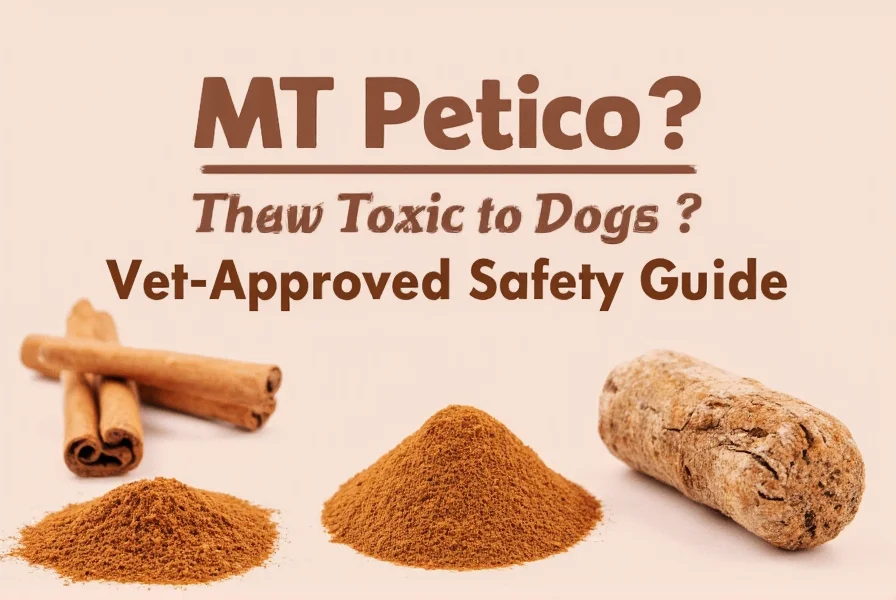Cinnamon is generally not toxic to dogs in small amounts, but it can cause health issues depending on the quantity consumed and form. While a tiny sprinkle of cinnamon in food won't harm most dogs, larger quantities—especially cinnamon powder or essential oils—can lead to respiratory problems, digestive upset, low blood sugar, and potential liver damage due to coumarin content. Immediate veterinary attention is recommended if your dog consumes significant amounts of cinnamon.
As a dog owner, discovering your pet has eaten something unexpected can cause immediate concern. Understanding the actual risks of common household spices like cinnamon helps you respond appropriately without unnecessary panic. This comprehensive guide examines the science behind cinnamon and canine health, providing evidence-based information to keep your furry friend safe.
Understanding Cinnamon's Effects on Dogs
When evaluating whether is cinnamon toxic to dogs, we must consider both the chemical composition of cinnamon and canine physiology. Cinnamon contains several compounds that affect dogs differently than humans:
- Coumarin - Higher in Cassia cinnamon (common in grocery stores), this compound can cause liver toxicity in large doses
- Cinnamaldehyde - The primary compound giving cinnamon its flavor and scent, which can irritate mucous membranes
- Eugenol - Found in smaller amounts, this can cause digestive upset
Dogs lack certain liver enzymes that help humans process these compounds efficiently, making them more susceptible to potential negative effects from larger quantities.
| Cinnamon Type | Coumarin Content | Risk Level for Dogs |
|---|---|---|
| Cassia (common) | High (up to 1%) | Moderate-High |
| Ceylon ("true") | Very Low (0.004%) | Low |
| Essential Oil | Concentrated | Very High |
Potential Health Risks of Cinnamon Exposure
When considering what happens if my dog eats cinnamon, several factors determine the severity of potential effects:
Inhalation Risks
Cinnamon powder poses significant inhalation risks. If your dog sniffs or is exposed to airborne cinnamon powder, it can cause:
- Severe respiratory irritation
- Coughing and choking
- Difficulty breathing
- Potential lung inflammation
This is particularly dangerous because dogs have smaller airways than humans, making them more vulnerable to respiratory complications from powdered substances.
Digestive System Effects
When dogs ingest cinnamon, the most common issues affect their digestive system. Symptoms of cinnamon poisoning in dogs may include:
- Vomiting
- Diarrhea
- Abdominal pain
- Decreased appetite
- Excessive drooling
Metabolic Concerns
Research indicates that large amounts of cinnamon may affect dogs' blood sugar regulation. While cinnamon sometimes helps regulate blood sugar in humans, in dogs it can potentially cause:
- Unexpected drops in blood glucose
- Weakness or lethargy
- Loss of coordination
Understanding Toxic Thresholds
Many dog owners wonder how much cinnamon is toxic to dogs. The answer depends on multiple factors including your dog's size, the type of cinnamon, and the form consumed.
For most adult dogs:
- Small amounts (less than 1 teaspoon of powder): Typically causes no serious issues but may lead to mild digestive upset
- Moderate amounts (1-2 tablespoons): Likely to cause vomiting, diarrhea, and possible respiratory irritation
- Large amounts (more than 2 tablespoons): Risk of more serious complications including potential liver damage from coumarin
Cinnamon essential oil represents a significantly higher risk. Even 1-2 drops can cause severe reactions due to its concentrated nature. Never apply cinnamon oil to your dog or allow them to ingest it.

Common Exposure Scenarios and Appropriate Responses
Understanding real-world situations where dogs encounter cinnamon helps determine appropriate responses. When evaluating can dogs have cinnamon in food, consider these common scenarios:
Accidental Ingestion of Powder or Sticks
If your dog knocks over a cinnamon container or chews a cinnamon stick:
- Immediately remove any remaining cinnamon
- Check for signs of inhalation (coughing, sneezing)
- Do not induce vomiting unless directed by a veterinarian
- Contact your vet with details about the amount consumed
Consumption of Cinnamon-Flavored Foods
Many baked goods contain cinnamon. The risk depends on both the cinnamon content and other ingredients:
- A small piece of cinnamon roll likely poses minimal risk
- Large quantities may cause digestive upset
- Be especially cautious with foods containing xylitol (a sweetener toxic to dogs)
Cinnamon Essential Oil Exposure
This represents the most dangerous scenario. If your dog contacts cinnamon oil:
- Wash skin exposure with mild soap and water
- If ingested, contact your vet or animal poison control immediately
- Do not give milk or oils, which can increase absorption
- Bring the product container to the vet appointment
When to Seek Veterinary Care
While cinnamon and dogs safety guidelines indicate small amounts rarely cause serious issues, certain symptoms warrant immediate veterinary attention:
- Difficulty breathing or persistent coughing
- Repeated vomiting or diarrhea
- Signs of weakness or collapse
- Excessive drooling or pawing at mouth
- Unusual lethargy lasting more than a few hours
When calling your veterinarian, provide specific details including:
- Approximate amount consumed
- Type of cinnamon (powder, stick, oil)
- Time of exposure
- Your dog's weight
- Any symptoms observed

Preventive Measures for Dog Owners
Preventing accidental exposure remains the best approach for is cinnamon bad for dog's health concerns. Implement these safety practices:
- Store spices securely in closed cabinets out of reach
- Be cautious when baking with cinnamon around dogs
- Avoid using cinnamon-based air fresheners or diffusers
- Never intentionally give cinnamon to dogs as a supplement
- Educate family members about potential risks
Scientific Research and Veterinary Consensus
Current veterinary research indicates that while cinnamon isn't among the most dangerous substances for dogs, it shouldn't be considered completely safe either. The American Kennel Club and ASPCA list cinnamon as generally nontoxic in small amounts but caution against significant exposure.
A 2022 review published in the Journal of Veterinary Pharmacology noted that while canine cinnamon toxicity cases remain relatively rare, the increasing popularity of essential oils has led to more emergency visits related to concentrated cinnamon products.
Safe Alternatives for Flavoring Dog Treats
If you're looking to add flavor to homemade dog treats, consider these safer alternatives:
- Pumpkin puree (unsweetened)
- Blueberries
- Peanut butter (xylitol-free)
- Plain yogurt
- Carrot puree
Always introduce new foods gradually and in small quantities to monitor for any adverse reactions.
Conclusion: Balancing Concern and Perspective
While understanding is cinnamon toxic to dogs requires careful consideration of multiple factors, the overall message remains clear: small accidental exposures typically pose minimal risk, but intentional feeding or significant accidental consumption warrants attention. By keeping cinnamon products securely stored and knowing the appropriate response to exposure, you can ensure your dog's safety without unnecessary anxiety about this common spice.
Frequently Asked Questions
Can dogs eat food with cinnamon in it?
A small amount of cinnamon in food typically won't harm dogs. Most baked goods contain insufficient cinnamon to cause problems, though large quantities may lead to digestive upset. The bigger concern with cinnamon-flavored foods is often other ingredients like sugar, fats, or potentially xylitol in some products.
What are the symptoms of cinnamon poisoning in dogs?
Symptoms of cinnamon exposure in dogs include vomiting, diarrhea, coughing, difficulty breathing, excessive drooling, low blood sugar (weakness, lethargy), and in severe cases, liver problems. Symptoms typically appear within a few hours of exposure and may last 24-48 hours.
How long after eating cinnamon will a dog show symptoms?
Symptoms of cinnamon exposure usually appear within 30 minutes to 2 hours after ingestion. Respiratory symptoms from inhaling powder may occur immediately, while digestive symptoms typically develop within a few hours. Liver-related issues from coumarin would take longer to manifest, usually requiring significant repeated exposure.
Is cinnamon essential oil more dangerous than cinnamon powder for dogs?
Yes, cinnamon essential oil is significantly more dangerous than cinnamon powder. Essential oils contain highly concentrated compounds that can cause severe reactions even in small amounts. Just 1-2 drops of cinnamon oil can cause chemical burns, severe digestive upset, and liver damage in dogs. Never use cinnamon essential oil around dogs without veterinary guidance.
Can cinnamon be used as a natural remedy for dogs?
Veterinarians generally don't recommend using cinnamon as a remedy for dogs. While some human studies suggest potential health benefits from cinnamon, dogs process it differently, and the risks often outweigh potential benefits. Always consult your veterinarian before giving any supplement to your dog, as safer, vet-approved alternatives typically exist for common canine health concerns.











 浙公网安备
33010002000092号
浙公网安备
33010002000092号 浙B2-20120091-4
浙B2-20120091-4